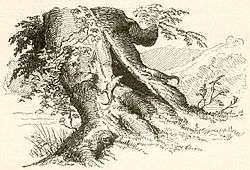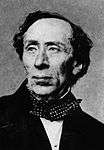The Elf Mound
| "The Elf Mound" | |
|---|---|
|
Illustration by Vilhelm Pedersen, Andersen's first illustrator | |
| Author | Hans Christian Andersen |
| Original title | "Elverhøi" |
| Country | Denmark |
| Language | Danish |
| Genre(s) | Fairy tale |
| Published in | New Fairy Tales. First Volume. Third Collection. 1845. (Nye Eventyr. Første Bind. Tredie Samling. 1845.) |
| Publication type | Fairy tale collection |
| Publisher | C.A. Reitzel |
| Media type | |
| Publication date | 7 April 1845 |
| Followed by | "The Red Shoes" |
"The Elf Mound" (Danish: Elverhøi) is a literary fairy tale by Danish poet and author Hans Christian Andersen (1805–1875). The tale is about a feast held in an elf mound for the Goblin Chief of Norway and his two sons, both of whom are expected to select elf brides. The tale was published in Copenhagen, Denmark by C.A. Reitzel in April 1845.
Plot summary
Two lizards scramble about the entrance to the Elf Mound, commenting on the hustle and bustle within. They have heard the elf maidens are practicing new dances and both wonder the reason why. An old maid elf hurries out and summons a raven to deliver invitations to an important event. The elf maidens begin their misty dances. The dishes for the night's festivities include skewered frogs, fungus salad made of mushroom seed, and hemlock. The king polishes his crown and tells his inquisitive youngest daughter that he has arranged marriages between two of his daughters and two of the sons of the Goblin Chief of Norway, who all arrive at that moment with pomp. The feast is held and the two sons prove rowdy and boisterous. The elf maidens are paraded as potential brides, declaiming their most notable talents. The Goblin Chief is so delighted he chooses one for his wife. Dawn approaches, and the old maid elf wants to close the shutters. The two sons of the Goblin King hurry outside to continue their tomfoolery and horseplay, leaving without selecting brides.
Publication history
The tale was first published by C.A. Reitzel in Copenhagen, Denmark on 7 April 1845 in New Fairy Tales. First Volume. Third Collection. 1845.. "The Elf Mound" was the first tale in the collection that included (in contents order) "The Red Shoes", "The Jumpers", "The Shepherdess and the Chimney Sweep", and "Holger the Dane". The tale was republished 18–December 1849 as a part of Fairy Tales. 1850. and again 30 March 1863 as a part of Fairy Tales and Stories. 1863. [1] The tale has since been published in various languages around the world.
Cultural impact
The most notable reference to the story is the Norwegian stage play Peer Gynt in which the Mountain King (Dovregubben), is clearly modeled on the Norwegian troll king in Andersen's tale. Henrik Ibsen was allegedly inspired by Andersen at the time. The Dutch composer Johan Wagenaar has composed a Elverhoi-ouverture Op. 48.
See also
References
External links
- "The Elf Mound" English translation by Jean Hersholt
- Elverhøi Original Danish text
- Elverhøi Original manuscript (Odense City Museums)

